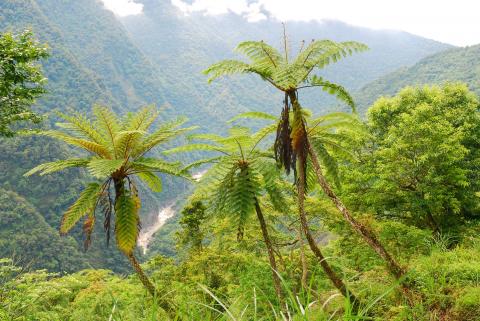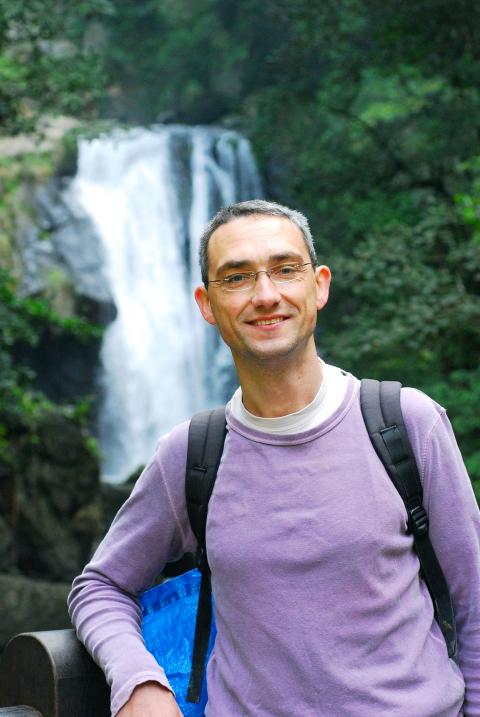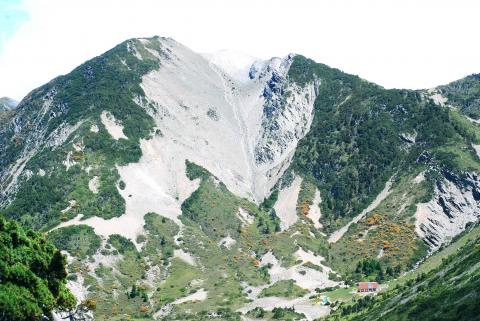When amateur researcher Ralf Knapp heard in November that a rare fern had been sighted for the first time in 80 years, the news “awoke an unrest” in him. Despite suffering a cold and the sometimes treacherous weather in Hohuanshan (合歡山), where the plant had been spotted, he climbed out of bed at 1am and drove four hours from his home in Muzha (木柵), Taipei City, to the mountain. In driving rain and soaked to the bone, he hiked 20km in near-freezing temperatures along trails that rose and plunged between 2,800m and 3,200m above sea level, to find his quarry.
Knapp, whose day job is electrical engineering, spent seven years in the field in Taiwan pursuing a passion for botany that he developed while growing up in Bavaria, Germany. That extensive fieldwork has paid dividends. On May 16, the Dr Cecilia Koo Botanic Conservation Center (財團法人辜嚴倬雲植物保種暨環境保護發展基金會保種中心) press launched his book Ferns and Fern Allies of Taiwan, the first major work on Taiwan’s fern botany in 15 years and one of the most comprehensive ever written.
Weighing in at 2.2kg and containing more than 4,000 high-resolution photos that detail almost all of Taiwan’s more than 700 species of ferns, the book is already considered a major work by experts.

Photo Courtesy of Ralf Knapp
Peng Ching-I (彭鏡毅) of Academia Sinica’s Biodiversity Research Center says the accomplishment is “quite unbelievable. This is much more than an amateur’s work. This is definitely worthy of reading by amateurs and professionals alike.”
Peng contrasts Knapp’s new book with Flora of Taiwan, whose six volumes were first published between 1975 and 1979 and for which he says some 100 researchers contributed in cataloguing more than 700 species for the guide’s section on ferns. Knapp cataloged the entries in his book single-handedly, photographing and often collecting the species in the field. He left blank spaces for the few he didn’t track down and invited others to make their own contributions.
“Academics don’t like to admit they don’t know something,” Peng says. “Even paid professionals don’t do this much research. And he’s doing it all in his free time.”

Photo Courtesy of Jing Zeng
Knapp’s book includes a “comments” section in which he raises questions and cites issues that are under-researched. This is “very valuable for future researchers,” Peng says.
Though he chose to pursue a career in engineering, Knapp is interested in science in general. His career eventually brought him to Taiwan. At first, he worked long hours and looked forward to visiting Germany, where he would indulge his passion for botany.
“Some of your interests, how do you explain?” he asks. “I can’t name it, it’s there. I’ve always been interested in nature.”

Photo Courtesy of Ralf Knapp
His Taiwanese wife, whom he met while hiking in the Austrian Alps when she was an exchange student in Germany, urged him to consider focusing on Taiwan.
He took her advice and soon found himself pursuing his interest with the same zeal he had as a teenager.
“When you go out there and you see all this diversity, every small patch of ground has its own kinds of plants and their strategies,” he says. It gives him “this desire to understand it.”
And “once getting into it, I want to take it to the end, take it as far as I can go,” he adds.
His research has taken him across thousands of kilometers through rough country all over Taiwan. He braved rock slides that once had him hanging from a cable above a 200m drop and got lost in steep canyons and deep jungles without water and other necessities. He’s encountered wild boars, stinging insects and venomous snakes and even contracted scrub typhus — twice.
Despite these challenges — or perhaps because of them — Knapp expresses joy in fieldwork.
The risks are very real. Landslides are common and mountains lush with jungle are often broken by slashes of bare earth and stones where the jungle floor has been swept into the valley below, the work of typhoons and earthquakes.
The lower altitudes are home to an array of deadly snakes and dangerous insects. At high altitudes, extreme weather can catch even a seasoned outdoorsman unprepared.
Knapp has found himself stranded overnight without camping gear in sub-zero temperatures.
“He’s a robot,” says Chen Cheng-wei (陳正為), a field researcher with the Taiwan Forestry Research Institute (林業試驗所) who worked with Knapp on many of his field trips. “He can get up at 2am and go hiking all day and drive back home. He’s incredible.”
Knapp says there are a number of reasons why Taiwan’s ferns are especially interesting. Rising from sea level to nearly 4,000m in less than 50km at some points, Taiwan is home to a wide array of sub-climates, from tropical to alpine, which gives rise to a unique diversity of flora and fauna. Also, unlike seed-bearing plants, ferns reproduce by virtue of tiny spores that can travel hundreds of kilometers. The winds that sweep across the ocean bring spores that land and grow throughout the country. Knapp has documented ferns in Taiwan that are otherwise only found in the Himalayas, as well as ferns that have cousins in Japan and the Philippines.
Peng, who is head of the Herbarium, Institute of Botany, Academia Sinica, Taipei, a facility that stores samples of plants, including most of the country’s endemic species, met Knapp early in his research and gave him access to the herbarium after office hours, as these were the only times he could conduct research. The favor was returned and Knapp donated hundreds of his own samples to the herbarium in return.
Peng was also instrumental in getting Knapp’s research to a publisher. The book was so ambitious in size and detail that several publishers wanted funding from Taiwan’s government to help produce it. He introduced Knapp to the Dr Cecilia Koo Botanic Conservation Center, a botanical center in Pingtung County that recognized the significance of the work and agreed to publish it.
Knapp plays down the significance of his work: “I’m not a scientist — I’m a hobbyist.” His book includes a number of species that are identified as endemic to Taiwan, which he says “implies responsibility to ensure their survival.”
Some species are so rare that they are found only in one area. Knapp knows of one such patch beside the Central Cross-Island Highway (中部橫貫公路) in an area that is vulnerable to destruction. “I really hope this book will contribute to raising awareness for conservation issues in Taiwan,” Knapp says.

On April 26, The Lancet published a letter from two doctors at Taichung-based China Medical University Hospital (CMUH) warning that “Taiwan’s Health Care System is on the Brink of Collapse.” The authors said that “Years of policy inaction and mismanagement of resources have led to the National Health Insurance system operating under unsustainable conditions.” The pushback was immediate. Errors in the paper were quickly identified and publicized, to discredit the authors (the hospital apologized). CNA reported that CMUH said the letter described Taiwan in 2021 as having 62 nurses per 10,000 people, when the correct number was 78 nurses per 10,000

May 5 to May 11 What started out as friction between Taiwanese students at Taichung First High School and a Japanese head cook escalated dramatically over the first two weeks of May 1927. It began on April 30 when the cook’s wife knew that lotus starch used in that night’s dinner had rat feces in it, but failed to inform staff until the meal was already prepared. The students believed that her silence was intentional, and filed a complaint. The school’s Japanese administrators sided with the cook’s family, dismissing the students as troublemakers and clamping down on their freedoms — with

As Donald Trump’s executive order in March led to the shuttering of Voice of America (VOA) — the global broadcaster whose roots date back to the fight against Nazi propaganda — he quickly attracted support from figures not used to aligning themselves with any US administration. Trump had ordered the US Agency for Global Media, the federal agency that funds VOA and other groups promoting independent journalism overseas, to be “eliminated to the maximum extent consistent with applicable law.” The decision suddenly halted programming in 49 languages to more than 425 million people. In Moscow, Margarita Simonyan, the hardline editor-in-chief of the

Six weeks before I embarked on a research mission in Kyoto, I was sitting alone at a bar counter in Melbourne. Next to me, a woman was bragging loudly to a friend: She, too, was heading to Kyoto, I quickly discerned. Except her trip was in four months. And she’d just pulled an all-nighter booking restaurant reservations. As I snooped on the conversation, I broke out in a sweat, panicking because I’d yet to secure a single table. Then I remembered: Eating well in Japan is absolutely not something to lose sleep over. It’s true that the best-known institutions book up faster